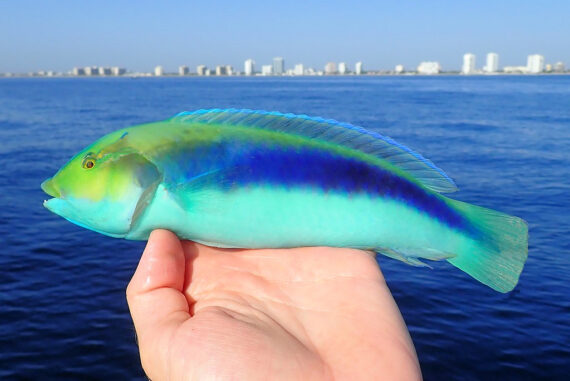Yellowcheek Wrasse, Halichoeres cyanocephalus
 Yellowcheek Wrasse, Halichoeres cyanocephalus, Terminal Phase (TP), Male. Fish caught from coastal waters off Broward County, Florida, August 2021. Length: 17 cm (6.8 inches). Catch, photograph and identification courtesy of Ben Cantrell, Sebastian, Florida.
Yellowcheek Wrasse, Halichoeres cyanocephalus, Terminal Phase (TP), Male. Fish caught from coastal waters off Broward County, Florida, August 2021. Length: 17 cm (6.8 inches). Catch, photograph and identification courtesy of Ben Cantrell, Sebastian, Florida.
 Yellowcheek Wrasse, Halichoeres cyanocephalus, Terminal Phase (TP), Male. Fish caught from coastal waters off Ft. Lauderdale, Florida, July 2021. Length: 21 cm (8.3 inches). Catch, photograph and identification courtesy of Chris Moore, Peoria, Arizona.
Yellowcheek Wrasse, Halichoeres cyanocephalus, Terminal Phase (TP), Male. Fish caught from coastal waters off Ft. Lauderdale, Florida, July 2021. Length: 21 cm (8.3 inches). Catch, photograph and identification courtesy of Chris Moore, Peoria, Arizona.
The Yellowcheek Wrasse, Halichoeres cyanocephalus, is a member of the Wrasse or Labridae Family, that is also known as the Lightning Wrasse and in Mexico as doncella, doncella cabeciplateada, doncella lomo amarillo and loro dienton negro. Globally, there are seventy species in the genus Halichoeres, seventeen of which are found in Mexican waters, ten in the Atlantic and seven in the Pacific Ocean.
The Yellowckeek Wrasse have elongated compressed bodies with a symmetrical upper and lower profile. The Juveniles and the Females (Initial Phase) have a white lower half of the head and a bright yellow upper half of the head which extends along the top of the back and a broad blue stripe that runs from the eye to the center of the caudal fin. The Juveniles have black centered ocellus on the base of the caudal and at the rear base of the dorsal fin which is absent in the females. Their caudal fin dark blue broadly edged above, below and the rear bright yellow; their dorsal fin is yellow with black stripe along its center. The Males (Terminal Phase) have upper heads along the back that are yellow, a blue stripe up the center of the snout and an oblique short dark red stripe from the eye up towards the nape; a broad blue stripe from above the pectoral fin base to base of the caudal fin. Their caudal fin is yellow, with a blue blotch at the base and their dorsal fin is black with a white margin. Their head has pointed snout with a protrusible mouth that opens in the front with thick lips that is equipped 1 pair of large canines at the front of the upper and 2 pairs at the front of the lower jaw and another at the rear of the top jaw. Their anal fin has 3 spines and 12 rays; their dorsal fin has 9 spines and 12 rays; and, their pectoral fins have 13 rays. They have 16 to 19 gill rakers. Their lateral line is continuous and deeply curved below the posterior portion of the dorsal fin.
The Yellowcheek Wrasse is a shallow-water coastal species that are found over and within sand substrate adjacent to reefs and hard substrate at depths up to 100 m (330 feet). The juveniles are found in shallow water environments and the adults in deeper waters. They reach a maximum of 30 cm (12 inches) in length. As of January 1, 2024, the International Game Fish Association world record stood at 0.45 kg (1 lb 0 oz) with the fish caught in coastal waters off Cape Hatteras, North Carolina, July 2023. They are active diurnally. They are known for burying themselves in the sand substrate to seek shelter including overnight for sleeping where they can remain for extended periods of time. The juveniles are known to clean other reef fish, including damselfish, goatfish, and surgeonfish, at defined cleaning stations on isolated rocks adjacent to sandy or gravel bottoms. They are dioecious with distinct females and males. They mate year-round as monogamous pairs with external fertilization. Their larvae are pelagic. They are covered with scales. The Yellowcheek Wrasse is poorly studied with very limited information available about their lifestyle and behavioral patterns including specific details on age, growth, longevity, movement patterns, diet, habitat use, and reproduction.
The Yellowcheek Wrasse is a resident of all Mexican waters of the Atlantic Ocean including the Gulf of Mexico and the east coast of the Yucatán Peninsula in the Caribbean. They are more common around the Yucatán than in the western parts of their range.
The Yellowcheek Wrasse cannot be easily confused with any other species with the possible exception of the Yellowhead Wrasse, Halichoeres garnoti (wide black bar along the back extending from the dorsal fin the to the caudal fin; second dorsal fin with 11 rays). The Yellowcheek Wrasse is the only Halichoeres in the Caribbean with 12 dorsal fin rays.
The Yellowcheek Wrasse are small in stature and of limited interest to most. From a conservation perspective, they are considered to be of Least Concern, with stable widely distributed populations. They are retained by subsistence fishermen for human consumption. They are caught by recreational anglers as a bi-catch. They are also utilized by the aquarium trade.